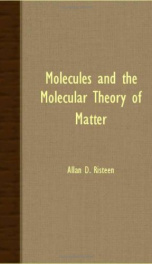molecules and the molecular theory of matter

MOLECULES ASD TIIE OF MATTER - 1896 - PREFACE. IN the multiplication of popular books on scientific subjects, the molecular theory of matter appears to have been strangely neglected. None of the works available to American readers pretend to give a complete, connected account of what is known of the constitution of matter, and the student who wishes to learn the present state of the molecular theory has to seek his information in the occasional artiiles that are scattered through the scientific journals. Dr. Watsons Kinetic Theory of Gases a new edition of which has been recently published is far too difficult for the undergraduates in our scientific schools and colleges Clausiuss Kinetische Theorie der Gase 1889-91 has not yet been translated, nor has Neyers Kinetische Theorze der Gase, so far as I am aware- JIeyer7s book is also out of print at present, although a new edition is in preparation. Lord Ielvin7s delightful lecture on The Size of Atoms should be read by all students of physics, and it is now readily available, in the first volume of his Popular Lectures and Addresses. Crookess classical papers on radiant matter should also be read they are in the Proceedings of the Royal Society, beginning with the year 1874. The present volume is an attempt to elucidate the elements of the molecular theory of matter as it is held to-day. It is based on a lecture delivered .on the 12th of last February, before the Washburn Engineering Society, of the Worcester Polytechnic Institute. In preparing the manuscript for the printer a considerable number of alterations have been made,. and much new material has been added, though the form of presentation has been preserved. Special care has been taken to exclude all matter except that mhich has an immediate and evident bearing on molecules otherwise this book would have been a treatise on physics. For this reason many exceedingly interesting theories and discoveries have been omitted or dismissed with slight mention - such, for example, as the investigations of Ostwald and others on solutions. It could hardly be expected that different men would agree on what should be passed over in this way, and it is likely that better judgment might have beenused in many places. It is also likely that there have been many oversights and accidental omissions. In some cases important theories have been passed over because it was believed that they could not be ad6quately discussed without introducing considerable digressions upon the phenomena they are intended to explain. Professor Ewings theory of magnetism is an example of this, and Clausiuss theory of electrolysis has been dismissed with a bare mention, for like reasons. Throughout this volume I have considered molecules in their physical aspect. There are numerous excellent works that discuss the chemical aspect of the molecular theory satisfactorily, of mhich the following may be particularly recdmmended .Meyer9s Jodern Theories of Chemistry Remsens Theoretical Chemistry, Ostwalds Outlines of General Chemistry, and Jiendeleieff S rinciles of Chemistry. HARTFORD, COKN., September 1, 1894. A. D. RISTEEN. a I CONTENTS. The Molecular Hypothesis . . . . Daltons Contribution . . . . . . Similarity of Iolecules ... . . . HypothesisofAvogadro . . . . . Distinction between BIolecules and Atoms . . Classcation of Bodies . . . . . BIolecular constitution of Solids . BIolecular Constitution of Liquids . IIolecular Constitution of Gases . . . . . . . . . . . . . . . . PAGE 1 2 4 5 - 6 . . . . . . 10 S . . 12 12 S . . . -14 PreliminaryRemarks . . . . . Molecular Collisions and Free Path . The Cause of Gaseous Pressure . . Molecules are Perfectly Elastic . . Velocities of Nolecules Unequal . . Statistical Method of Investigation . . . . . . . . . . . . . . . . . . . . . . . . . . . . . . . ...
Info about the book
Author:
Series:
Unknown
ASIN:
364284331X
Rating:
3/5 (3)Your rating:
0/5
Languge:
English
Users who have this book
Users who want this book
What readers are saying
What do you think? Write your own comment on this book!
write a commentGenre
if you like molecules and the molecular theory of matter try:
Other books by this author
Do you want to read a book that interests you? It’s EASY!
Create an account and send a request for reading to other users on the Webpage of the book!

